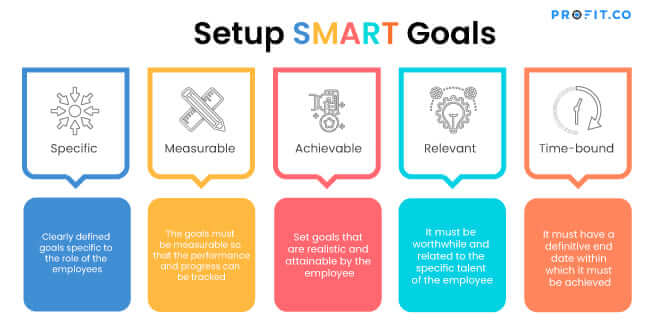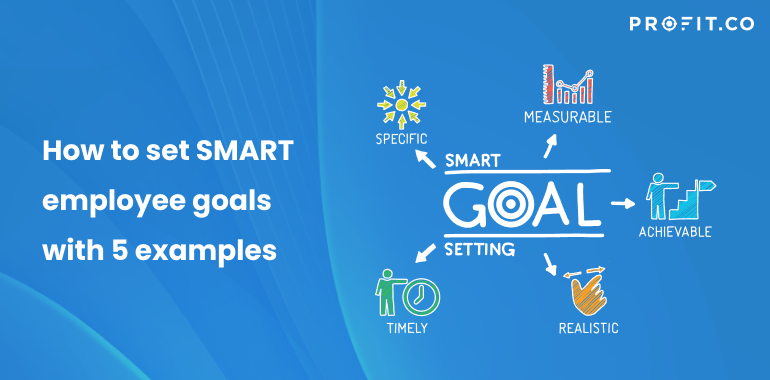Setting goals is an important practice in any organization. It’s an essential part of the performance management process and is used to achieve business objectives. It helps boost performance, for when you have something to aim for, it helps you prioritize and focus.
A goal must answer the who, what, when, where, why, and how of the expectations of the goal. When there’s a clear objective, people will be more dedicated to reaching their set goal. It is beneficial for both employees and for the company.
7 Ways that Goal setting benefits an Organization
- It helps to have a vision of where you want to be. And when you have a vision, you can chalk out a path to get there.
- It helps employees understand why they are doing their work and how it can contribute to the organization’s good.
- When you have something to achieve and strive to get there, it almost automatically builds accountability.
- It makes work more meaningful and encourages employees to be more involved and passionate about their work instead of just getting it done.
- A more involved attitude towards work leads to deeper employee engagement
- It helps keep people on track and motivates them more than factors such as financial gain.
- It acts as a reference guideline for performance review
As a manager, it’s very important that your team members have very specific goals. Employee goals are extremely important to help your team achieve newer levels of success. Each member of your team must be aware of what their goals are, what the company’s goals are, and how their individual goals tie in with the company’s goals.
Goals and motivation go hand in hand when difficulty is taken into account. Motivation and commitment suffer a setback if goals are set too high. Difficult to achieve goals not only affects motivation and commitment, but it also leads to dishonesty and cutting corners.
One of the most common and behavioural biases during goal setting is Loss aversion. As the name implies occurs when the psychological impact of losing something outweighs the pleasure of gaining. It is good to have a knowledge of all these factors during our goal-setting process.
In the words of Denis Waitley, the best-selling author of the audio series, The Psychology of Winning, “The reason most people never reach their goals is that they don’t define them, or ever seriously consider them as believable or achievable.
Winners can tell you where they are going, what they plan to do along the way, and who will be sharing the adventure with them.
Therefore, it is important to ensure that the goals that are set for each employee are not too difficult, but challenging and achievable, and are aligned to the overall growth strategy of the company. This would lead to better employee performance.
Try our Agile Performance Management software for FREE
SMART Goals
When you set goals that help create a system to track and measure progress, which helps promote employee and organizational success, they are referred to as SMART goals. By setting SMART goals, you’re providing employees with an understanding of the goal, its purpose, and why it matters.

SMART goals are
- Specific: Clearly defined goals specific to the role of the employees
- Measurable: The goals must be measurable so that the performance and progress can be tracked
- Achievable: Set goals that are realistic and attainable by the employee
- Relevant: It must be worthwhile and related to the specific talent of the employee
- Time-bound: It must have a definitive end date within which it must be achieved
Employees’ motivations will depend upon how the goals are set, which, in turn, is what will determine employee performance. For setting goals, the best-known goal management and execution framework, as industry leaders believe, is OKR (Objectives and Key Results). Apart from goal setting, OKR framework ensures that the entire organization is aligned and executes with agility to achieve strategic and tactical goals. It provides the complete framework for leaders to collaboratively define their goals, cascade them to their teams, review progress, have conversations with the team, as well as recognize their hard work, and finally reflect and reset goals by the end of the quarter.
For setting goals, the best-known goal management and execution framework, as industry leaders believe, is OKR (Objectives and Key Results). Apart from goal setting, OKR framework ensures that the entire organization is aligned and executes with agility to achieve strategic and tactical goals. It provides the complete framework for leaders to collaboratively define their goals, cascade them to their teams, review progress , have conversations with the team, as well as recognize their hard work, and finally reflect and reset goals by the end of the quarter.
Incorporating SMART criteria into goal-setting within the performance management system ensures clarity, accountability, and alignment with organizational objectives, facilitating employee growth and organizational success.
How to set SMART employee goals with OKRs?
OKRs can be set at different levels- individual, team, department and corporate, and they can be aligned top down or bottom up according to the organization’s requirements. During the goal setting phase, the ‘Planning’ exercise gives freedom to various departments and teams to define their OKRs with a condition – They need to “align” them to the corporate OKRs. ensures two things: One, it empowers various teams to set their own goals, giving them better ownership and job satisfaction, and two, it ensures that the corporate goals are cascaded down to have a better chance of achieving.
OKRs have been tracked by Spreadsheets from the early days of computing, and are still used by small teams (ten or less) for the limited purpose of planning their OKRs. However, using spreadsheets to implement OKRs does not serve the needs of a serious organization or any type of user – CXOs, Department heads, Managers or Individual contributors.
Using a great intuitive OKR Software can help teams to stay productive and execute with focus and alignment. Instead of worrying about the problems associated with spreadsheets, team members can spend quality time on deciding stretch targets, innovative ways to achieve them, a great “Conversations, Feedback and Review framework” to improve employee engagement and focus on execution.
When it comes to setting goals, most managers follow a well-established set of practices to make their goals SMART. They hold one-on-one meetings with their subordinates to set goals, and then they review performance against those objectives at year end and link their appraisal to promotion and bonus decisions.
Following are a few employee performance goals along with their examples. OKRs can also be used to set up smart goals, in fact the key results (KR) on OKR methodology are nothing but a version of smart goals.
1. Smart Goals example for Collaboration
Goals that aim at supporting a colleague in achieving their goals to encourage collaboration. Encouraging team members to be collaborative helps them build a good rapport with each other which helps them work better individually and together.
Example
- Help a colleague complete one of their projects this quarter.
Here is how a OKR can set a SMART goal: The Key results are essentially smart goals to be achieved in order to fulfil the objective
Objective: Create Multilingual Marketing Content
- KR1: Create 40 product videos in Spanish to aid LATAM Spanish sales
- KR2: Create e-book on “performance management with OKRs” in Brazilian Portuguese
- KR3: Create 25 conceptual videos on Performance Management in German
2. Smart goal example for Professional Development
No matter how smart or talented an employee is, there is always something they can still learn and ways they can grow as both individuals and professionals. These goals help employees stay up-to-date and relevant and in a competitive market.
Example
Complete the Content Marketing certification course by the end of the month and start with a Social Media Marketing Certification course by the beginning of next month.
A sample OKR has been added below:
Objective: Build a team of 5 marketing consultants from the marketing team
- KR1: Complete one certification course on digital marketing
- KR2: Give product demo on new features to internal customers at least once a month
- KR3: Increase the Number of Managers (Project manager and above) Having Succession Planning Done from 60% to 90%
3. Smart goals example for Creative Performance
Being creative is essential to many different workplace responsibilities, whether it is how you manage a project, arrive at a solution, how you manage your team. It is very important to have a creative bent of mind to be successful in your career. Everyone is creative in their own ways. There are ways to improve one’s creative abilities.
Example
- Go for a 30-minute walk during lunch break
- Pick up a new hobby or get back to a hobby that you love like painting, gardening, running by the end of Q3 A sample OKR has been added below:
Objective: Improve Existing Web Page Quality
- KR1: Add at least 3-5 customer stories in home page
- KR2: Replace existing images with custom-designed graphics For 15 WebPages
- KR3: Add relevant infographics for at least 25 recently added blogs
4. Smart goals example towards Complex Problem solving
One of the things that differentiate humans from robots is their problem solving skills. Complex problem solving skills, creativity and analytical and logical thinking are all closely linked. It is possible to get better at your complex problem solving skills by finding different avenues to hone it. The simplest known solution is breaking a complex problem into smaller tasks and accomplishing them one at a time.
Example
- When you’re faced with a problem and are struggling with it, list out all the possible solutions, however insignificant they might seem, and attempt to tackle the problem, by Q3
- Find articles/quizzes that improve your problem solving skills by the end of the quarter
To accomplish an Objective , a complex Key Result can be split into small tasks, the completion of all of which will lead to accomplishment of the Objective. A sample for one such objective is shown below:
Objective: Improve website look and feel
- KR1: Revamp Home page design benchmarking competitors.
- Competitor analysis
- Benchmark wireframe design
- Implement wireframe to WordPress with responsive design
- Implement WordPress responsive design to staging
- Test design in staging web
- Test design in staging compatibility testing in mobile devices
- Move to Production – Web
- Move to Production – devices
- Test in Production.
- KR2: Revamp Answers page design benchmarking as blog page.
- Benchmark wireframe design
- Implement wireframe to WordPress with responsive design
- Implement WordPress responsive design to staging
- Test design in staging web
- Test design in staging compatibility testing in mobile devices
- Move to Production – Web
- Move to Production – devices
- Test in Production
5. Smart Goals examples for People Management
Collaboration and teamwork are extremely important for a company’s growth and success. Being able to motivate your team members and being a team player has an enormous impact on productivity and performance.
Example
- Be empathetic: Everyday, for 30 minutes, put yourself in your team member’s shoes and try to look at things from their perspective, and how they feel about things in their situation. Do this until the end of Q4.
- Reward the work of your team members. Every month, until the end of Q4, recognize the work of one of your teammates (like an employee of the month), by sending them an email, and to the rest of the team about the employee of the month.
- Make it an inclusive work culture for everyone to talk freely and express their opinions
A sample OKR has been added below:
Objective: Increase Employee Engagement
- KR1: Increase Employee Satisfaction Score from 70% to 90%
- KR2: Improve Glassdoor.com rating from 3 to 4.5
- KR3: Increase employee participation in quarterly retreats from 75% to 95%
In Summary
Goals are a powerful tool to drive strategy execution. To harness their potential, leaders must move beyond the conventional wisdom of traditional goal setting and their entrenched practices. Setting SMART goals as a best practice in any organization is paving the way for the organization’s success. The key is to find that sweet spot between motivation and goal difficulty — the goal should be set high enough to encourage good performance but low enough to be attainable. Setting unrealistic and irrelevant goals can cause stress and anxiety and lead to employee attrition. Which, in turn, will affect the growth of the company. When it comes to injecting excellence in employee performance, one size does not fit all. However, goal setting done right with a powerful framework like that of Profit.co’s OKR and Performance management module can increase the employee’s productivity, and transform the organizational success as a whole.
Frequently asked questions :
Q1. What are good goals for a performance review examples?
Answer : When it comes to setting goals for a performance review, most managers follow a well-established set of practices to make their goals SMART. They hold one-on-one meetings with their subordinates to set goals, and then they review performance against those objectives at year end and link their appraisal to promotion and bonus decisions.
Good Goal Examples as shown in the above article can be collaboration goals, creativity, people management and problem solving.
Q2. What are SMART performance goals?
Any goals setup for tracking employee performance based on the principles of SMART can be called smart performance goals. Example : To achieve 30% of annual target in Q1.




